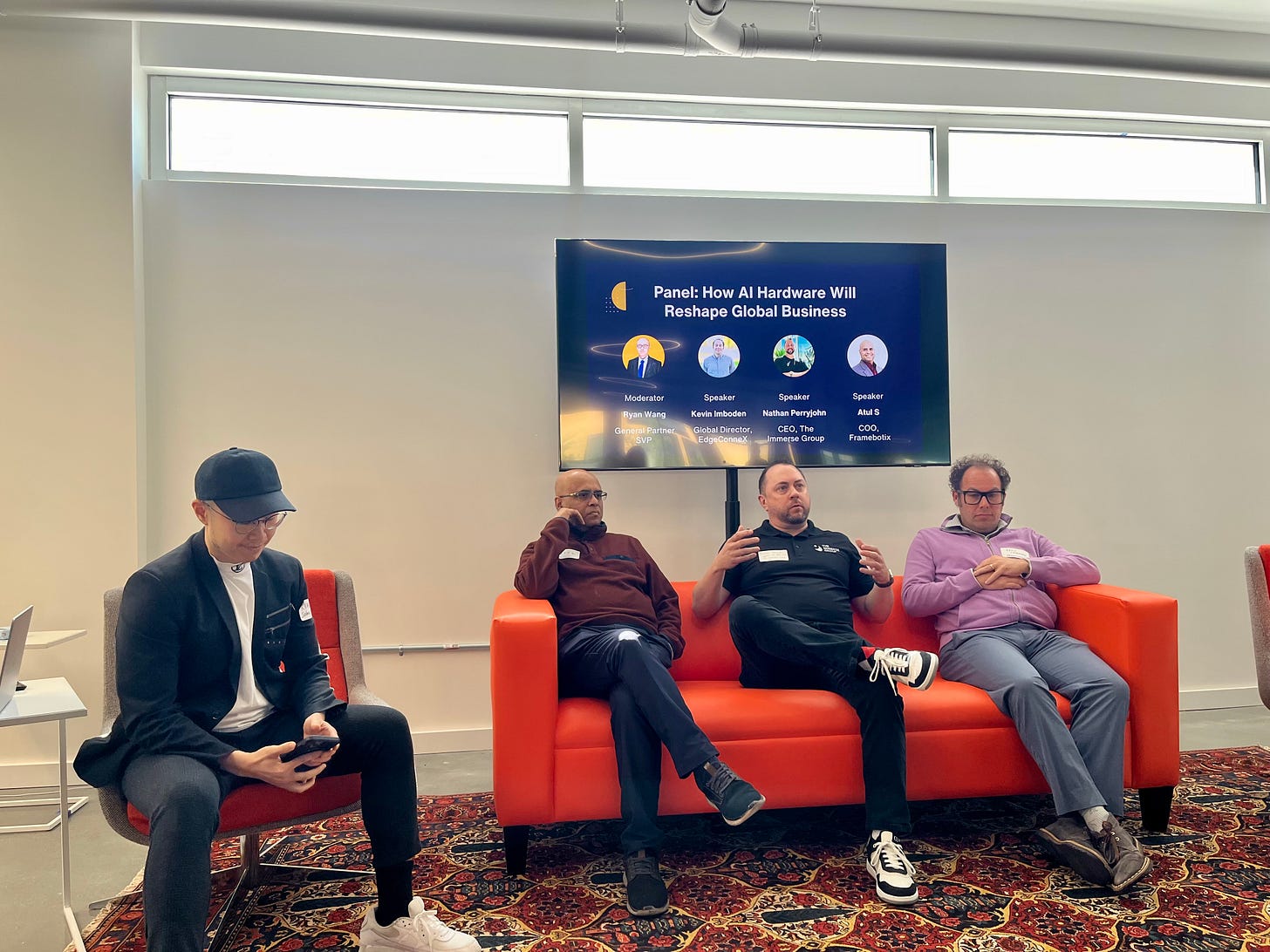The Great Convergence: How AI, XR, and Wearable Tech Will Redefine Work and Play
Here are major trends I believe every business leader and innovator needs to be tracking related to AI-enabled XR devices, Edge AI chipsets, and wearable technology that transforming global business.
This week, I had the privilege of attending an event hosted by Solaris Venture Partners in Menlo Park, bringing together alumni from the China Europe International Business School (CEIBS) and leaders across the technology ecosystem.
First, a heartfelt thank you to Patti Pan for her outstanding organization of the event, and to Ryan Wang, Partner at Solaris, who moderated a truly insightful panel discussion on "How AI Hardware Will Reshape Global Business."
It was an honor to join fellow panelists Kevin Imboden, Global Director at EdgeConneX, and Atul Shinde, COO at Frambotix, for a dynamic conversation on how emerging technologies are moving from innovation labs into the real economy.
The morning event also featured a thought-provoking fireside chat led by Kayvan Baroumand, longtime Bay Area investor and startup enabler, who shared powerful insights on navigating the next wave of technology disruption.
Throughout the day, it was inspiring to connect with professionals from NVIDIA, TCL, Apple, and many other pioneering organizations who are actively shaping the future of AI, XR, and next-generation computing.

Key Themes from the Event and Industry Trends
As I reflected on the conversations and keynotes from the day, it became clear:
we are at the beginning of a massive convergence of AI-enabled XR devices, GenAI models, Edge AI hardware, and wearable technologies. This a convergence that will fundamentally transform how we work, live, and play.
Here are a few major trends I believe every business leader and innovator needs to be tracking:
1. Mobile-Connected XR Glasses Are Becoming Reality
Thanks to advancements in mobile tethering (via 5G and WiFi 6/7), XR glasses are becoming an extension of smartphones, not standalone devices.
Companies like Meta (with Ray-Ban Smart Glasses), XREAL (formerly Nreal), and TCL (with RayNeo) are leading the charge, enabling lightweight, stylish, and highly functional AR glasses that connect directly to your mobile device.
This solves one of the biggest barriers to mainstream adoption:
keeping AR glasses lightweight and affordable without sacrificing processing power.
2. Edge AI Hardware Unlocks Real-Time Experiences
Dedicated AI chipsets like Qualcomm's AR1 Gen 1, Snapdragon XR2, and Apple’s Neural Engine are all bringing real-time intelligence directly to devices.
This allows for:
Contextual awareness (e.g., “What building am I looking at?”)
Computer vision for object and scene recognition
Hands-free GenAI assistants that understand voice, gestures, and environment simultaneously
By moving AI inference to the edge, latency is minimized, privacy is enhanced, and devices become truly assistive companions, not just displays.
3. GenAI Will Power the Next Generation of Wearables
Generative AI models, the same ones transforming text, images, and video today, are also being miniaturized and optimized for wearable hardware.
Imagine glasses that can:
Summarize meetings and emails as you walk between appointments.
Translate live conversations across languages instantly.
Suggest action items based on what you’re seeing and hearing.
Suggest or automatically connect you on social media after you meet.
Proactively surface opportunities, risks, or creative ideas in your field of view.
The fusion of GenAI + XR wearables will make human-computer interaction more seamless, intuitive, and personalized than ever before.
4. Mobile Carriers and Chipset Companies Are Accelerating the Ecosystem
Telecom giants like AT&T, Verizon, China Mobile, and Deutsche Telekom aren’t standing on the sidelines, they’re actively investing in 5G Advanced and preparing for 6G to support the heavy demands of immersive, real-time AI+XR experiences.
At the same time, chipset companies like Qualcomm, MediaTek, and Huawei are building the hardware backbone that will power smart glasses, spatial computing devices, and AI-driven wearables at scale.
This collaboration between carriers and chipmakers ensures that XR+AI won’t be isolated gimmicks, but rather, they'll be part of the next generation of connected work, commerce, education, and entertainment.
Where I’m Focused: Helping Emerging Tech Companies Scale
At The Immerse Group, I work with emerging XR and AI companies to help them land Fortune 100 clients and strategic partnerships.
Our goal is simple: to bridge the gap between cutting-edge innovation and real-world enterprise deployment.
I believe companies that can master the convergence of wearables, AI hardware, and spatial intelligence will define the next decade, and I’m excited to support visionary founders and teams on that journey.
Final Thought
We are moving from a world where your phone was your portal to information…
...to a world where your glasses will be your lens to an intelligent, spatial, and AI-augmented universe.
The future of work won’t just be mobile, it will be context-aware, proactive, and wearable.
And the businesses that move decisively into this new paradigm will create massive opportunities across industries.
Excited for what lies ahead and grateful for communities like Solaris Venture Partners, CEIBS alumni, and the innovators leading the way.
#AI #XR #EdgeAI #Wearables #EmergingTech #BusinessDevelopment #Innovation #CEIBS #FutureOfWork #GenAI #SpatialComputing




